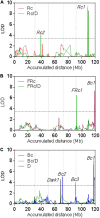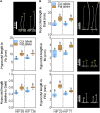Ultra-High-Density QTL Marker Mapping for Seedling Photomorphogenesis Mediating Arabidopsis Establishment in Southern Patagonia
- PMID: 34367202
- PMCID: PMC8343176
- DOI: 10.3389/fpls.2021.677728
Ultra-High-Density QTL Marker Mapping for Seedling Photomorphogenesis Mediating Arabidopsis Establishment in Southern Patagonia
Abstract
Arabidopsis thaliana shows a wide range of genetic and trait variation among wild accessions. Because of its unparalleled biological and genomic resources, Arabidopsis has a high potential for the identification of genes underlying ecologically important complex traits, thus providing new insights on genome evolution. Previous research suggested that distinct light responses were crucial for Arabidopsis establishment in a peculiar ecological niche of southern Patagonia. The aim of this study was to explore the genetic basis of contrasting light-associated physiological traits that may have mediated the rapid adaptation to this new environment. From a biparental cross between the photomorphogenic contrasting accessions Patagonia (Pat) and Columbia (Col-0), we generated a novel recombinant inbred line (RIL) population, which was entirely next-generation sequenced to achieve ultra-high-density saturating molecular markers resulting in supreme mapping sensitivity. We validated the quality of the RIL population by quantitative trait loci (QTL) mapping for seedling de-etiolation, finding seven QTLs for hypocotyl length in the dark and continuous blue light (Bc), continuous red light (Rc), and continuous far-red light (FRc). The most relevant QTLs, Rc1 and Bc1, were mapped close together to chromosome V; the former for Rc and Rc/dark, and the latter for Bc, FRc, and dark treatments. The additive effects of both QTLs were confirmed by independent heterogeneous inbred families (HIFs), and we explored TZP and ABA1 as potential candidate genes for Rc1 and Bc1QTLs, respectively. We conclude that the Pat × Col-0 RIL population is a valuable novel genetic resource to explore other adaptive traits in Arabidopsis.
Keywords: Arabidopsis; HIFs; Patagonia; QTL; RILs; seedling de-etiolation.
Copyright © 2021 Matsusaka, Filiault, Sanchez and Botto.
Conflict of interest statement
The authors declare that the research was conducted in the absence of any commercial or financial relationships that could be construed as a potential conflict of interest.
Figures





Similar articles
-
Functional analysis of PHYB polymorphisms in Arabidopsis thaliana collected in Patagonia.Front Plant Sci. 2022 Sep 7;13:952214. doi: 10.3389/fpls.2022.952214. eCollection 2022. Front Plant Sci. 2022. PMID: 36161012 Free PMC article.
-
High-density linkage map construction and QTL analyses for fiber quality, yield and morphological traits using CottonSNP63K array in upland cotton (Gossypium hirsutum L.).BMC Genomics. 2019 Nov 21;20(1):889. doi: 10.1186/s12864-019-6214-z. BMC Genomics. 2019. PMID: 31771502 Free PMC article.
-
Light-response quantitative trait loci identified with composite interval and eXtreme array mapping in Arabidopsis thaliana.Genetics. 2004 Jun;167(2):907-17. doi: 10.1534/genetics.103.024810. Genetics. 2004. PMID: 15238539 Free PMC article.
-
A single haplotype hyposensitive to light and requiring strong vernalization dominates Arabidopsis thaliana populations in Patagonia, Argentina.Mol Ecol. 2017 Jul;26(13):3389-3404. doi: 10.1111/mec.14107. Epub 2017 May 2. Mol Ecol. 2017. PMID: 28316114
-
Quantitative trait loci and candidate genes underlying genotype by environment interaction in the response of Arabidopsis thaliana to drought.Plant Cell Environ. 2015 Mar;38(3):585-99. doi: 10.1111/pce.12418. Epub 2014 Sep 3. Plant Cell Environ. 2015. PMID: 25074022
Cited by
-
Genome-wide association studies for soybean epicotyl length in two environments using 3VmrMLM.Front Plant Sci. 2022 Nov 14;13:1033120. doi: 10.3389/fpls.2022.1033120. eCollection 2022. Front Plant Sci. 2022. PMID: 36452100 Free PMC article.
-
Functional analysis of PHYB polymorphisms in Arabidopsis thaliana collected in Patagonia.Front Plant Sci. 2022 Sep 7;13:952214. doi: 10.3389/fpls.2022.952214. eCollection 2022. Front Plant Sci. 2022. PMID: 36161012 Free PMC article.
References
-
- Alonso-Blanco C., Peeters A. J. M., Koornneef M., Lister C., Dean C., Van Bosch N., et al. (1998). Development of an AFLP based linkage Map of Ler, Col and Cvi Arabidopsis thaliana ecotypes and construction of a Ler/Cvi recombinant inbred line population. Plant J. 14 259–271. - PubMed
LinkOut - more resources
Full Text Sources
Molecular Biology Databases

